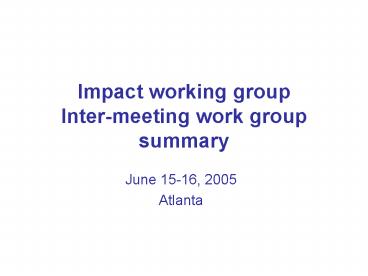Impact working group Intermeeting work group summary - PowerPoint PPT Presentation
1 / 35
Title:
Impact working group Intermeeting work group summary
Description:
Previous hospitalization. Fedson ... 62-67% of those who died had a recent hospitalization ... Previous P/I hospitalization ... – PowerPoint PPT presentation
Number of Views:61
Avg rating:3.0/5.0
Title: Impact working group Intermeeting work group summary
1
Impact working groupInter-meeting work group
summary
- June 15-16, 2005
- Atlanta
2
Disease impact workgroup goals
- Part I Describe impact of past pandemics on
groups by age and underlying conditions - Part II Determine whether data support
sub-prioritization of high risk beyond current
inter-pandemic tiering
3
Participants
- Ted Eickhoff, UCHSC
- Paul Glezen, Baylor Coll. Of Med
- Marika Iwane, NIP, CDC
- Susan Lett, CSTE
- Megan Lindley, ASPH
- Arnold Monto, U. of Mich. School of Public Health
- Kathy Neuzil, ACP
- Ishmael Ortega-Sanchez, NIP, CDC
- David Shay, NCID, CDC
- Rich Schieber, NIP, CDC
- Ben Schwartz, NVPO
- Bill Thompson, NIP, CDC
- Pascale Wortley, NIP, CDC
4
Assumptions
- Very limited antiviral supplysome high risk
groups may be prioritized for prophylaxis or
early therapy - Vaccine production at rate of approximately 20
million doses per month, necessitating
sub-prioritization of high risk
5
Part I a. Clinical Attack rates
6
Influenza attack rates, 1918 (Frost 1919)
approximations based on figurehousehold surveys
conducted Dec 1918
7
Attack rate by community, 1918 (Frost 1920)
8
Clinical attack rates during Fall 1957
lab-confirmed
9
Clinical attack rates Nov 1968-Jan 1969
weekly mean averages
10
b. Death rates
11
1918 PI death rates (Frost 1919)
approximations based on figure
12
Age-Specific Influenza Death Rates Among Females
in England and Wales, 1918
?
Nguyen-Van-Tam, JS, et al. Vaccine, 2003
21762-68.
13
PI death rates per 100,000 population, 108
cities, Aug-Dec 1957 (Dauer 1958)
Age group
14
PI death rates per 100,000 population, 1968-69
(Luk 2001)
Age group
15
c. Excess death rates
16
1918 excess death rates (Luk 2001)
17
Fall 1957 excess death rates
PI, compared to previous year All cause,
modeling PI, modeling
18
1968 excess PI death rates (Luk 2001)
19
Source Serfling 1967
20
Age-specific excess mortality by pandemic
numbers and rates per 100,000 (Simonson 1998)
21
Part II Sub-prioritizing
the high risk
22
Specific conditions pregnancy
- 1918-19 and 1957-58 data are limited but suggest
pregnant women were at increased risk of death - 1968-69 no data on impact on pregnant women
- Interpandemic influenza pregnant women are high
risk but not at higher risk than other high risk
groups unless they have another underlying HR
condition.
23
Specific conditions bone marrow transplants
- Limited studies (Nichols 2004, Whimbey 1994) ,
but both suggest high rates of complications. - Largest study (Nichols) 18/62 BMT pts with lab
confirmed influenza had LRI 6/62 died (5 of 6
had LRI) - Likely greater benefit from antiviral drugs than
vaccine
24
Hospitalizations and Deaths per 1,000
Unvaccinated Persons 65 1996-1998
Year 1 range 36-86 Year 2 range 36-56
Renal disease, immunodeficiency or receipt of
organ transplants, non hematologic cancer
Source Hak 2002 CID
25
Hospitalizations and Deaths per 10,000 Persons
15-64 1973-1992
Range 36-76/10,000
Neuzil 1999 JAMA Neuzil 2003 JAIDS
NS
HIV-HAART data 1995-1999
26
PI death rates 1968-69 and 72-73, by condition,
Oregon HMO, all ages combined (Barker 1982)
27
Number of high risk conditions, Oregon HMO,
1968-69 and 1972-73 (Barker 1982)
28
Previous hospitalization
- Fedson
- 39 to 46 of elderly discharged for
influenza-associated respiratory conditions had
recent hospitalization - 62-67 of those who died had a recent
hospitalization - 6 of 65-74 (12 of 75) had a hospital
discharge during vaccination season (Sept 1-Nov
30)
Annals of Internal Medicine 1992116550-5
29
Association of clinical characteristics with
hospitalization due to pneumonia or influenza and
death due to any cause, during the influenza
season among persons gt64 (Hak 2004)
Immunodeficiency and organ transplants
30
Potential criteria for sub-prioritization of
high risk
- Age high mortality in lt1 in pandemics among
adults increasing risk with age (18-49 vs 50-64) - Number of high risk conditions.
- History of hospitalization for high risk
condition or PI. - Severe immunosuppression, e.g. BMT. -data not
available for other immuno- compromised
subpopulations.
31
Inter-pandemic prioritization
32
Size of specific groups
groups may overlap
33
Potential subprioritization of high risk, cont
- Pro
- High risk within tiers are not equal,
sub-prioritization could help target most
vulnerable first as vaccination of some groups
will take several months (e.g. gt40 million 2-64
with HR) - Con
- Implementation may be challenging
- Data are limited
34
Extra slide
35
Pregnancy
- Harris 1919 case series of pregnant women with
influenza 50 had pneumonia, and 50 case
fatality rate w/ pneumonia (7-9th months 60 vs
1-6 m45-53). - Woolston 1918 2154 pts admitted to Cook County
Hospital 50 of pregnant women died compared
with 33 of other pts. - Greenberg 1958 NYC mortality data fall 195747
PI deaths in women 15-49 22/47 (47) were
pregnant women.















![[CSCW] Computer Supported Cooperative Work PowerPoint PPT Presentation](https://s3.amazonaws.com/images.powershow.com/7918627.th0.jpg?_=20160622076)















